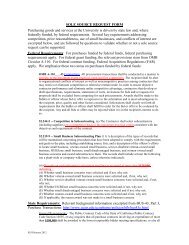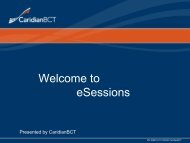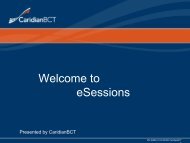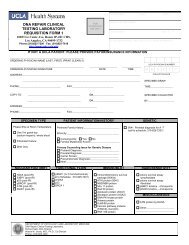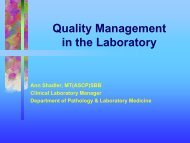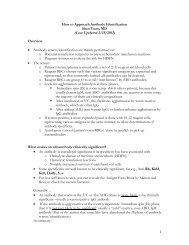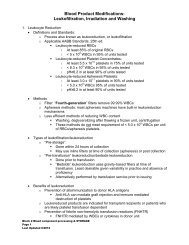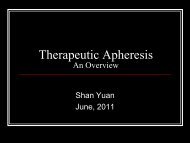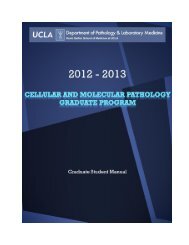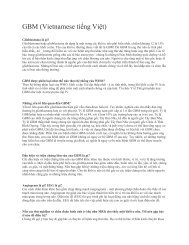TRANSFUSION MEDICINE - the UCLA Department of Pathology ...
TRANSFUSION MEDICINE - the UCLA Department of Pathology ...
TRANSFUSION MEDICINE - the UCLA Department of Pathology ...
Create successful ePaper yourself
Turn your PDF publications into a flip-book with our unique Google optimized e-Paper software.
®<strong>TRANSFUSION</strong><strong>MEDICINE</strong>NO. TM 11-4 (TM-328)Transfusion medicineVolume 54Brian Nagao, MD<strong>Pathology</strong> ResidentShan Yuan, MDAssistant Pr<strong>of</strong>essor <strong>of</strong> <strong>Pathology</strong> and Laboratory MedicineAssistant Director, Transfusion Medicine & Blood BankingNumber 4ISSN 1056-5949© ascp May 2011Qun Lu, MDAssistant Pr<strong>of</strong>essor <strong>of</strong> <strong>Pathology</strong> and Laboratory MedicineAssistant Director, Transfusion Medicine & Blood Banking<strong>Department</strong> <strong>of</strong> <strong>Pathology</strong> and Laboratory MedicineDavid Geffen School <strong>of</strong> MedicineUniversity <strong>of</strong> California at Los AngelesLos Angeles, CaliforniaIf you wish to obtain an MOC self-assessment module (SAM) creditfor this exercise, please log-in to www.ascp.org, go to My Courses, andselect <strong>the</strong> appropriate course now to take your pre-test.41
LEARNING OBJECTIVEStransfusion medicineTM 11-4© ASCP 2011Upon completion <strong>of</strong> this exercise, <strong>the</strong> participant should be able to• recognize immune-mediated hemolysis.• develop a differential diagnosis for immune-mediated hemolysis.• diagnose drug-induced immune hemolytic anemia.• diagnose drug-induced immune thrombocytopenia.• recommend appropriate management for both conditions.Copyright © 2010 2011 by <strong>the</strong> American Society for Clinical <strong>Pathology</strong>. All rights reserved. Copyright law allows formultiple copy duplication <strong>of</strong> <strong>the</strong> Check Sample exercises and color images (printed or digital) for classroom useand for in-service continuing education by nonpr<strong>of</strong>it groups. Written permission is not required in <strong>the</strong>se casesas long as copies made do not exceed <strong>the</strong> number <strong>of</strong> students or participants and copies are not charged for. Allo<strong>the</strong>r uses including reproduction, storage in a retrieval system, or transmission in any form or by any means(including electronic, mechanical, photocopying, or recording) require prior written permission <strong>of</strong> <strong>the</strong> AmericanSociety for Clinical <strong>Pathology</strong>, checksample@ascp.org. Check Sample® is a registered trademark <strong>of</strong> <strong>the</strong> AmericanSociety for Clinical <strong>Pathology</strong>.The American Society for Clinical <strong>Pathology</strong> (ASCP) is accredited by <strong>the</strong> Accreditation Council for ContinuingMedical Education to provide continuing medical education (CME) for physicians.The ASCP designates this educational activity for 1 AMA PRA Category 1 Credit TM . Physicians should only claim creditcommensurate with <strong>the</strong> extent <strong>of</strong> <strong>the</strong>ir participation in <strong>the</strong> activity.These activities meet <strong>the</strong> American Board <strong>of</strong> <strong>Pathology</strong>’s Maintenance <strong>of</strong> Certification Program Part II Lifelong Learningrequirements.Select ASCP continuing education activities are accepted by California, Florida, and many o<strong>the</strong>r states for relicensure<strong>of</strong> clinical laboratory personnel. ASCP designates <strong>the</strong>se activities for <strong>the</strong> indicated number <strong>of</strong> Continuing MedicalLaboratory Education (CMLE) credits. ASCP CMLE credits are acceptable to meet <strong>the</strong> continuing education requirementsfor <strong>the</strong> ASCP Board <strong>of</strong> Registry Certification Maintenance Program. All ASCP CMLE programs are conductedat intermediate to advanced levels <strong>of</strong> learning.The primary purpose <strong>of</strong> this activity is educational and <strong>the</strong> comments, opinions, and/or recommendations expressed byauthors are <strong>the</strong>ir own and not those <strong>of</strong> <strong>the</strong> ASCP. The author(s) has no relevant financial relationship with commercialinterests that provide products and/or services discussed in this exercise.Materials will be replaced without charge, worldwide, if <strong>the</strong> publisher receives a request within 90 days <strong>of</strong> <strong>the</strong>mailing date.For subscription information, address corrections, or notification <strong>of</strong> damaged shipments, contact <strong>the</strong> ASCP.For answer sheet instructions and <strong>the</strong> latest updates, please visit http://credit.ascp.org/. Credit for 2011Credit Check Sample for 2010 exercises Check Sample may be exercises earned through may be December earned through 31, 2013. December 31, 2012.42
HISTORYA 73-year-old woman underwent surgical repair <strong>of</strong> a ventral hernia. After anuneventful postoperative course, she was discharged on postoperative day 4. Aroundday 9, she developed progressive weakness, ligh<strong>the</strong>adedness, and dark urine, and had1 episode <strong>of</strong> emesis <strong>of</strong> clear fluid. She presented to <strong>the</strong> authors’ institution on day 14.Review <strong>of</strong> all o<strong>the</strong>r systems was unremarkable. Her medical history was significantfor colon cancer 7 years earlier treated with surgical resection and chemo<strong>the</strong>rapy,hypertension, hyperlipidemia, hypothyroidism, and gastroesophageal reflux disease.Her outpatient medications included carvedilol, nifedipine, captopril, losartanhydrochlorothiazide,ezetimibe-simvastatin, thyroxine, esomeprezole, ranitidine,aspirin, and tramadol.transfusion medicineTM 11-4© ASCP 2011Her vital signs were: blood pressure, 128/93 mmHg; pulse rate, 81/min; respirations,18/min; and temperature, 98.4°F (36.9°C). Oxygen saturation on room air was100%. Her abdominal wound was healing with no evidence <strong>of</strong> bleeding or infection.No skin rashes, petechiae, ecchymoses, or mucosal hemorrhages were present. Thefecal occult blood test result was negative. The rest <strong>of</strong> her physical examination resultswere unremarkable.Relevant admission laboratory results are shown in Laboratory Data. Thepatient had severe anemia with evidence <strong>of</strong> hemolysis, including reticulocytosis,unconjugated hyperbilirubinemia, a low haptoglobin level, an elevated level <strong>of</strong> lactatedehydrogenase, and hemoglobinemia. The peripheral smear showed abundantmicrospherocytes and no schistocytes. Her blood type was group A Rh+. Theantibody screen result was negative. The direct antiglobulin test (DAT) result waspositive for IgG and negative for C3. An acid elution was performed, and <strong>the</strong> eluatewas nonreactive with reagent red blood cells (RBCs). She was admitted for RBCtransfusions and evaluation <strong>of</strong> her hemolytic anemia.LABORATORY DATA.Test Patient Result Reference RangeWhite blood cell count, ×10 3 /µL (×10 9 /L) 5.50 (5.50) 3.28-9.29 (3.28-9.29)Red blood cell count, ×10 6 /µL (×10 12 /L) 1.96 (1.96) 3.76-4.93 (3.76-4.93)Hemoglobin, g/dL (g/L) 6.2 (62) 11.5-14.6 (115-146)Hematocrit, % 18.7 34.0-42.1Platelet count, ×10 3 /µL (×10 9 /L) 207 (207) 143-398 (143-398)Mean corpuscular volume, fL 95.4 79.0-95Absolute reticulocyte count, ×10 6 /µL (×10 9 /L) 0.1942 (194.2) 0.0273-0.1072 (27.3-107.2)Haptoglobin, mg/dL (µmol/L)
een proven. 5 There are some anecdotal reports <strong>of</strong> successful treatment <strong>of</strong> refractoryDIIHA with plasmapheresis. 10Drug-Induced Immune Thrombocytopenia (DIIT)Background and PathophysiologyIn addition to hemolytic anemia, drugs can cause thrombocytopenia throughsimilar immune-mediated processes. Heparin-induced thrombocytopenia is <strong>the</strong>most common and well described <strong>of</strong> <strong>the</strong>se entities and is caused by antibodies withspecificity to complexes <strong>of</strong> platelet factor 4 and heparin. This results in moderatethrombocytopenia 5 to 14 days after treatment. Bleeding is uncommon, butthrombosis occurs in more than one half <strong>of</strong> patients. 11 DIIT due to o<strong>the</strong>r drugs is rareand is associated with more severe thrombocytopenia and increased risk <strong>of</strong> bleeding.The incidence <strong>of</strong> DIIT is estimated at 10 persons per million per year, thoughthis is likely an underestimate. 12 The data <strong>of</strong> George and colleagues, who reviewedcases <strong>of</strong> DIIT reported through 2008, is available online: http://www.ouhsc.edu/platelets. According to <strong>the</strong>ir criteria (explained in detail at <strong>the</strong> website), 51 drugs aredefinite and 17 o<strong>the</strong>rs are probable causes <strong>of</strong> DIIT. Based on <strong>the</strong>ir analysis, DIITis most commonly associated with quinine and sulfonamide antibiotics. Quinidine,nonsteroidal anti-inflammatory drugs, rifampin, vancomycin, anticonvulsants, goldsalts, antineoplastics (fludarabine, oxaliplatin), and platelet inhibitors (tir<strong>of</strong>iban,eptifibatide, and abciximab) are also implicated. 12transfusion medicineTM 11-4© ASCP 2011DIIT is most commonlyassociated with quinineand sulfonamideantibiotics.Several pathophysiologic mechanisms have been proposed. An early model suggestedthat drugs bind covalently to platelet membrane proteins and act as haptens to induceformation <strong>of</strong> drug-dependent antibodies in a process analogous to DIIHA causedby high-dose penicillin. This may account for <strong>the</strong> rare cases <strong>of</strong> thrombocytopeniacaused by penicillin, piperacillin, and cephalosporins, but does not explain DIITcaused by o<strong>the</strong>r drugs. 12 For more than 20 years, <strong>the</strong> major hypo<strong>the</strong>sis was <strong>the</strong>“immune complex” mechanism, which proposed that some drugs can react directlywith antibodies to produce immune complexes that target platelets for destruction.However, <strong>the</strong>se complexes have never been demonstrated experimentally, and thishypo<strong>the</strong>sis has since fallen out <strong>of</strong> favor. 12 A newer model suggests that drug-dependentantibodies are probably derived from naturally occurring autoantibodies with weakaffinity for platelet membrane glycoproteins. The presence <strong>of</strong> certain drugs improves<strong>the</strong> binding <strong>of</strong> <strong>the</strong> antibody to <strong>the</strong> platelet membrane glycoprotein (GP; typicallyGPIIb-IIIa or GPIb-V-IX). Examples <strong>of</strong> such drugs include quinine, sulfonamideantibiotics, nonsteroidal anti-inflammatory drugs, and anticonvulsants. 12Some drugs induce formation <strong>of</strong> true autoantibodies that can bind directly to plateletsin a drug-independent manner. One to 2% <strong>of</strong> patients treated with gold salts developplatelet autoantibodies. 12,13 Autoantibodies can also arise in response to L-dopa,procainamide, penicillamine, interferon α and β, and occasionally sulfonamideantibiotics. 12,13 This form <strong>of</strong> DIIT is clinically indistinguishable from idiopathicthrombocytopenic purpura and is diagnosed on clinical grounds.Several novel DIIT mechanisms have been described and are worth noting. Fibansare a class <strong>of</strong> platelet inhibitor drugs that includes tir<strong>of</strong>iban and eptifibatide. Theywork by binding to <strong>the</strong> recognition site on GPIIb-IIIa, preventing its interaction47
transfusion medicineTM 11-4© ASCP 2011Factors that favor DIITinclude: unexplainedacute thrombocytopeniafollowing any drugadministration, severethrombocytopenia(a platelet count <strong>of</strong>
on discovery that cefotetan and cefazolin were administered prophylactically forsurgery. To evaluate for possible DIIHA, <strong>the</strong> patient’s serum and eluate were sentto <strong>the</strong> American Red Cross Reference Laboratory (Pomona, CA) with <strong>the</strong> followingresults: The patient’s undiluted serum caused complete hemolysis <strong>of</strong> cefotetan-coatedRBCs; a 1:100 dilution <strong>of</strong> serum strongly agglutinated cefotetan-coated RBCs; <strong>the</strong>eluate also reacted with cefotetan-coated RBCs; all test results <strong>of</strong> non–drug-coatedRBCs were negative; and parallel test results for cefazolin drug-dependent antibodieswere negative. The findings confirmed <strong>the</strong> diagnosis <strong>of</strong> DIIHA due to cefotetan.Fur<strong>the</strong>rmore, <strong>the</strong> in vitro lysis <strong>of</strong> cefotetan-coated RBCs supported <strong>the</strong> suspicion thatintravascular hemolysis had occurred in vivo. Cefotetan DIIHA typically presentswith IgG-mediated extravascular hemolysis, which <strong>the</strong> patient clearly had, basedon <strong>the</strong> positive IgG, unconjugated hyperbilirubinemia, and <strong>the</strong> microspherocyteson <strong>the</strong> peripheral smear. Occasionally, cefotetan DIIHA involves complementmediatedintravascular hemolysis producing a DAT positive for C3. 3 The evidence<strong>of</strong> intravascular hemolysis in <strong>the</strong> patient included hemoglobinemia, nearly absenthaptoglobin, and a very high lactate dehydrogenase level. Although C3 was notdetected in <strong>the</strong> patient’s DAT, <strong>the</strong> authors suspect that this was due to total hemolysis<strong>of</strong> <strong>the</strong> complement-coated RBCs in vivo.transfusion medicineTM 11-4© ASCP 2011Despite <strong>the</strong> patient’s severe anemia, she recovered after transfusion <strong>of</strong> several units <strong>of</strong>RBCs and was discharged in stable condition. After <strong>the</strong> diagnosis <strong>of</strong> cefotetan DIIHAwas confirmed, she was advised to avoid cefotetan, and her drug allergy list wasupdated.REFERENCES1. Petz L, Garratty G. Immune HemolyticAnemia. 2nd ed. Philadelphia, PA:Churchill Livingston: 2004.2. Berentsen S, Beiske K, Tjønnfjord G.Primary chronic cold agglutinin disease: anupdate on pathogenesis, clinical featuresand <strong>the</strong>rapy. Hematology. 2007;12(5):361–370.3. Ogose T, Wakata Y, Kaneko M, et al.A case <strong>of</strong> recurrent paroxysmal coldhemoglobinuria with <strong>the</strong> differenttemperature thresholds <strong>of</strong> Donath-Landsteiner antibodies. J Pediatr HematolOncol. 2007;29(10):716-719.4. Viraghavan R, Chakravarty A, Soreth J.Cefotetan-induced haemolytic anaemia. Areview <strong>of</strong> 85 cases. Adv Drug React ToxicolRev. 2002;21:101-107.5. Garratty G. Drug-induced immunehemolytic anemia. Hematology Am SocHematol Educ Program. 2009:73-79.6. Salama A. Drug-induced immunehemolytic anemia. Expert Opin Drug Saf.2009;8(1):73-79.7. Garratty G, Arndt PA. An update ondrug-induced immune hemolytic anemia.Immunohematology. 2007;23(3):105-119.8. Johnson ST, Fueger JT, Gottschall JL.One center’s experience: <strong>the</strong> serologyand drugs associated with drug-inducedimmune hemolytic anemia-a new paradigm.Transfusion. 2007;47(4):697-702.9. Arndt PA, Garratty G. The changingspectrum <strong>of</strong> drug-induced immunehemolytic anemia. Semin Hematol.2005;42(3):137-144.10. Garratty G. Drug-induced immunehemolytic anemia. Clin Adv Hematol Oncol.2010;8(2):98-101.11. Arepally GM, Ortel TL. Heparin-inducedthrombocytopenia. Annu Rev Med.2010;61:77-90.12. Aster RH, Curtis BR, McFarland JG, et al.Drug-induced immune thrombocytopenia:pathogenesis, diagnosis, and management.J Thomb Haemost. 2009;7(6):911-918.13. Aster RH, Bougie, DW. Drug-inducedimmune thrombocytopenia. N Engl J Med.2007;357(6):580-587.49
transfusion medicineTM 11-4© ASCP 201114. Andres E, Dali-Youcef N, Serraj K,et al. Recognition and management<strong>of</strong> drug-induced cytopenias: <strong>the</strong>example <strong>of</strong> idiosyncratic drug-inducedthrombocytopenia. Expert Opin Drug Saf.2009;8(2):183-190.15. Kenney B, Stack G. Drug-inducedthrombocytopenia. Arch Pathol Lab Med.2009;133(2):309-314.16. Visentin GP, Liu CY. Drug-inducedthrombocytopenia. Hematol Oncol ClinNorth Am. 2007;21(4):685-696.50
CME DOCUMENTATION QUESTIONS1. Which <strong>of</strong> <strong>the</strong> following sets <strong>of</strong> laboratory data is most consistent with immunemediatedhemolysis?A) Hemoglobin (Hg), 8.2 g/dL (11.5-14.6); total bilirubin,4.5 mg/dL (0.2-1.1 mg/dL); conjugated bilirubin, 3.9 mg/dL(0.0-0.2 mg/dL); lactate dehydrogenase (LDH), 305 U/L (91-223 U/L);haptoglobin, 35 mg/dL (30-190 mg/dL); absolute reticulocyte count,0.0513 ×10 6 /µL (0.0273-0.1072 ×10 6 /µL); direct antiglobulin test (DAT),1+ (weak) IgGB) Hg, 6.6 g/dL; total bilirubin, 3.1 mg/dL; conjugated bilirubin,0.3 mg/dL; LDH, 1703 U/L; haptoglobin,
transfusion medicineTM 11-4© ASCP 20114. A 42-year-old woman presents with thrombocytopenia (platelet count24,000/µL) 1 week after starting quinine for nocturnal muscle cramps.Drug-induced immune thrombocytopenia (DIIT) is suspected. Which <strong>of</strong> <strong>the</strong>following is true?A) Detection <strong>of</strong> drug-induced antibodies (by flow cytometry) is <strong>of</strong>tendiagnostic.B) DIIT is unlikely because platelet counts are rarely less than 50,000/µL.C) DIIT is unlikely because <strong>the</strong> interval between drug administration andthrombocytopenia is too short.D) The diagnosis <strong>of</strong> DIIT due to quinine is clinical because it cannot bedistinguished from idiopathic thrombocytopenic purpura by laboratorytests.5. A 25-year-old woman presents with purpura and epistaxis 8 days after startingtrimethoprim-sulfamethoxazole for cystitis. A complete blood cell countdemonstrates a platelet count <strong>of</strong> 45,000/µL. After <strong>the</strong> diagnosis <strong>of</strong> DIIT isconfirmed, you advise <strong>the</strong> patient thatA) Upon cessation <strong>of</strong> <strong>the</strong> drug, at least 3 weeks are required for <strong>the</strong> plateletcount to return to normal.B) Platelet transfusions will reduce her mortality.C) Plasma exchange hastens recovery.D) Corticosteroids have no proven benefit.Note: To receive CME credit, please submit your answers online. To view answer sheetinstructions and updates, please visit http://www.ascp.org/checksampleinstructions. Welook forward to bringing you better results with online answer submission and certificatesthat can be printed immediately upon course completion!52





